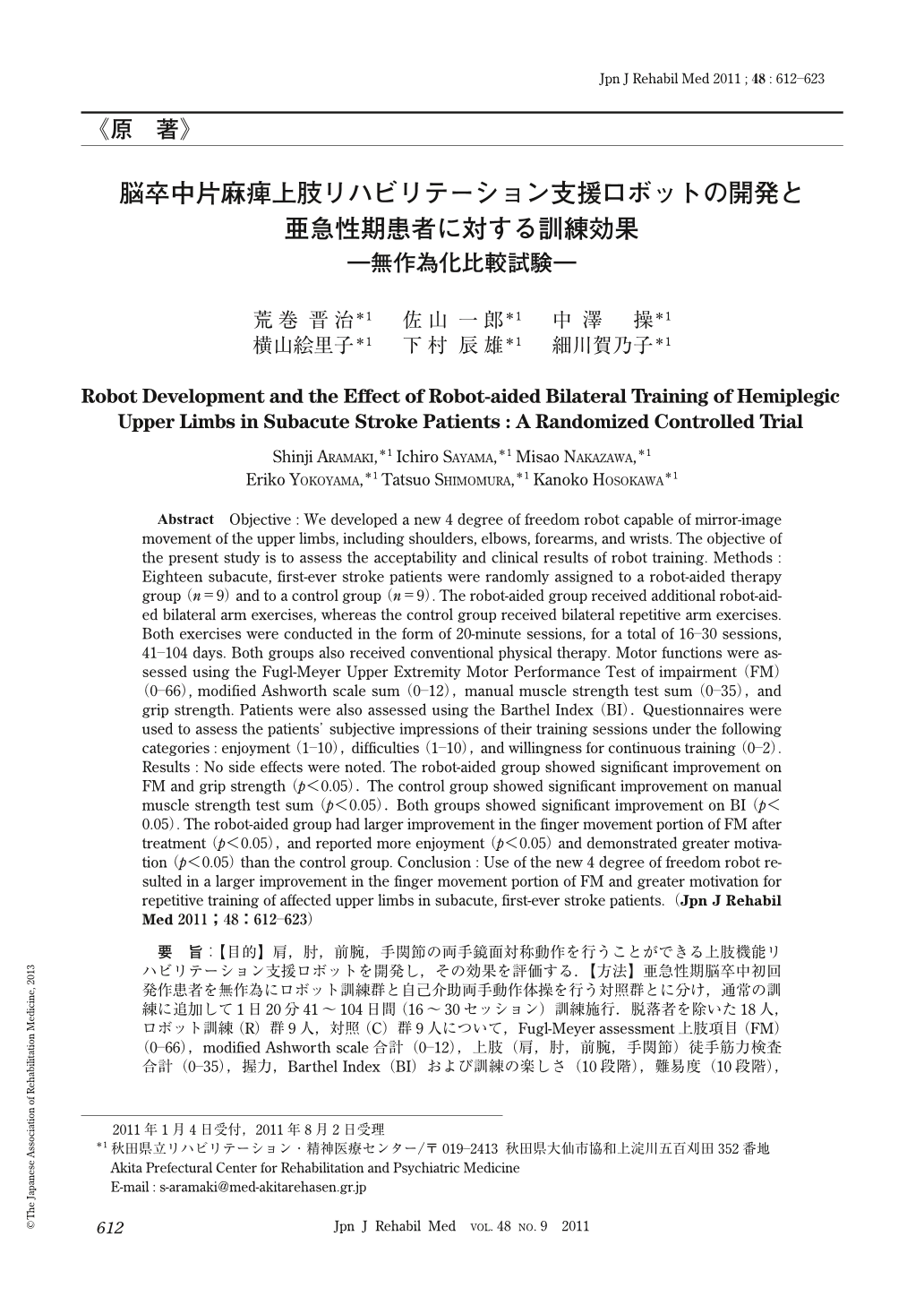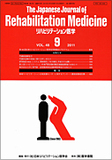Japanese
English
- 販売していません
- Abstract 文献概要
- 1ページ目 Look Inside
- 参考文献 Reference
要旨:【目的】肩,肘,前腕,手関節の両手鏡面対称動作を行うことができる上肢機能リハビリテーション支援ロボットを開発し,その効果を評価する.【方法】亜急性期脳卒中初回発作患者を無作為にロボット訓練群と自己介助両手動作体操を行う対照群とに分け,通常の訓練に追加して1日20分41~104日間(16~30セッション)訓練施行.脱落者を除いた18人,ロボット訓練(R)群9人,対照(C)群9人について,Fugl-Meyer assessment上肢項目(FM)(0-66),modified Ashworth scale合計(0-12),上肢(肩,肘,前腕,手関節)徒手筋力検査合計(0-35),握力,Barthel Index(BI)および訓練の楽しさ(10段階),難易度(10段階),持続性(3段階)のインタビュー結果を評価した.【結果】ロボット訓練で有害事象はなかった.R群でFM,握力,C群で上肢筋力合計,両群でBIが有意に改善した(p<0.05).R群はC群と比較してFM手指項目改善量,楽しさ,持続性で有意に優っていた(p<0.05).【結論】新しく開発した上肢機能リハビリテーション支援ロボットによる訓練は,対照群と比較して手指機能および繰り返し訓練に対するモチベーションを向上させた.
Abstract Objective : We developed a new 4 degree of freedom robot capable of mirror-image movement of the upper limbs, including shoulders, elbows, forearms, and wrists. The objective of the present study is to assess the acceptability and clinical results of robot training. Methods : Eighteen subacute, first-ever stroke patients were randomly assigned to a robot-aided therapy group (n=9) and to a control group (n=9). The robot-aided group received additional robot-aided bilateral arm exercises, whereas the control group received bilateral repetitive arm exercises. Both exercises were conducted in the form of 20-minute sessions, for a total of 16-30 sessions, 41-104 days. Both groups also received conventional physical therapy. Motor functions were assessed using the Fugl-Meyer Upper Extremity Motor Performance Test of impairment (FM) (0-66), modified Ashworth scale sum (0-12), manual muscle strength test sum (0-35), and grip strength. Patients were also assessed using the Barthel Index (BI). Questionnaires were used to assess the patients' subjective impressions of their training sessions under the following categories : enjoyment (1-10), difficulties (1-10), and willingness for continuous training (0.2). Results : No side effects were noted. The robot-aided group showed significant improvement on FM and grip strength (p<0.05). The control group showed significant improvement on manual muscle strength test sum (p<0.05). Both groups showed significant improvement on BI (p<0.05). The robot-aided group had larger improvement in the finger movement portion of FM after treatment (p<0.05), and reported more enjoyment (p<0.05) and demonstrated greater motivation (p<0.05) than the control group. Conclusion : Use of the new 4 degree of freedom robot resulted in a larger improvement in the finger movement portion of FM and greater motivation for repetitive training of affected upper limbs in subacute, first-ever stroke patients.

Copyright © 2011, The Japanese Association of Rehabilitation Medicine. All rights reserved.


